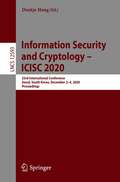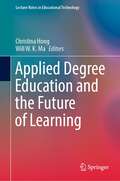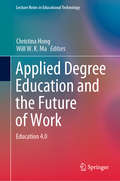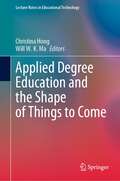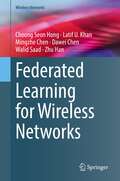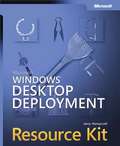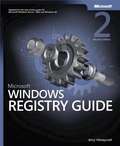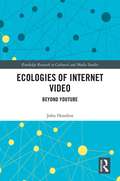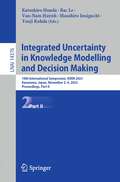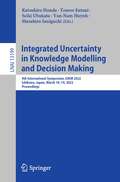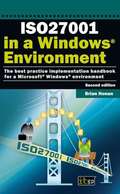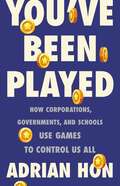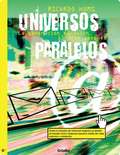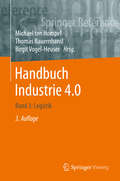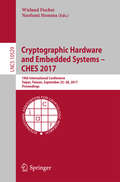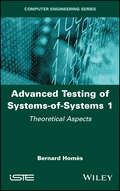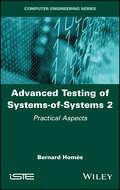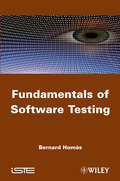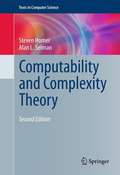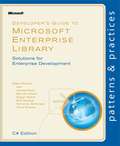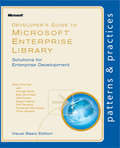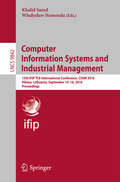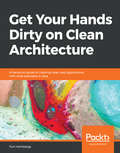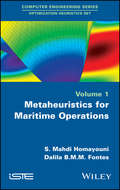- Table View
- List View
Information Security and Cryptology – ICISC 2020: 23rd International Conference, Seoul, South Korea, December 2–4, 2020, Proceedings (Lecture Notes in Computer Science #12593)
by Deukjo HongThis book constitutes selected papers from the 23rd International Conference on Information Security and Cryptology, ICISC 2020, held in Seoul, South Korea, in December 2020. Due to the COVID-19, the confere was held online.The total of 15 papers presented in this volume were carefully reviewed and selected from 51 submissions. The aim of this conference was to provide an international forum for the latest results of research, development, and applications within the field of information security and cryptology.
Applied Degree Education and the Future of Learning (Lecture Notes in Educational Technology)
by Christina Hong Will W. K. MaThis book draws on the responses to learning and teaching and applied education futures thinking, that provide insights into the future of learning. It brings together more than 30 novel and important applied research and scholarly contributions from around the world, including Australia, Canada, Finland, Germany, Hong Kong, Japan, Macau, Mainland China, Malaysia, Morocco, Pakistan, and the UK. The chapters, including reflective essays and practice-based case examples, are divided into five major themes:• Future ready values and competencies for the future of work• Innovative pedagogies in applied degree learning and training• Driving student access, engagement, and success through digital technologies• Intelligent technologies: Embedding the new world of work into applied degrees• Lifelong learning, partnering, and the future of workThis book is important for readers interested in international perspectives on the future of work and professional education.
Applied Degree Education and the Future of Work: Education 4.0 (Lecture Notes in Educational Technology)
by Christina Hong Will W. K. MaThis edited volume sets the stage for discussion on Education 4.0, with a focus on applied degree education and the future of work. Education 4.0 refers to the shifts in the education sector in response to Industry 4.0 where digital transformation is impacting the ways in which the world of work and our everyday lives are becoming increasingly automated. In the applied degree sector, significant change and transformation is occurring as leaders, educators and partners evolve smart campus environments to include blended learning, artificial intelligence, data analytics, BYOD devices, process automation and engage in curriculum renewal for and with industries and professions. This volume aims to profile and enhance the contribution of applied educational practice and research particularly in the applied degree sector and includes contributions that show case real world outcomes with students and industry as partners. This edited volume includes a wide range of topics, such as rethinking the role of education and educators; curriculum and the future of work; industrial partnership, collaboration and work integrated learning; vocational and professional practices; students, industry and professions as partners; employability skills and qualities for the 21st century world of work; innovative pedagogy and instructional design; adaptive learning technologies; and data analytics, assessment and feedback. The contributors come from different parts of the world in higher education, including, Canada, China, Finland, Germany, Hong Kong, Italy, Macau, Singapore and the United Kingdom.
Applied Degree Education and the Shape of Things to Come (Lecture Notes in Educational Technology)
by Christina Hong Will W. K. MaThis edited book seeks to evolve a global community of practice to share case studies, engage in critical discussion and spearhead thought leadership, to address the paradigm shift in next generation educational practice. This book showcases novel research studies in various forms and engenders interdisciplinary conversation and exchange concerning innovation, technology, and the role of applied education in workforce futures. It also equips readers with global perspectives on the latest developments in applied degree education and thinking on new education futures.
Federated Learning for Wireless Networks (Wireless Networks)
by Choong Seon Hong Latif U. Khan Mingzhe Chen Dawei Chen Walid Saad Zhu HanRecently machine learning schemes have attained significant attention as key enablers for next-generation wireless systems. Currently, wireless systems are mostly using machine learning schemes that are based on centralizing the training and inference processes by migrating the end-devices data to a third party centralized location. However, these schemes lead to end-devices privacy leakage. To address these issues, one can use a distributed machine learning at network edge. In this context, federated learning (FL) is one of most important distributed learning algorithm, allowing devices to train a shared machine learning model while keeping data locally. However, applying FL in wireless networks and optimizing the performance involves a range of research topics. For example, in FL, training machine learning models require communication between wireless devices and edge servers via wireless links. Therefore, wireless impairments such as uncertainties among wireless channel states, interference, and noise significantly affect the performance of FL. On the other hand, federated-reinforcement learning leverages distributed computation power and data to solve complex optimization problems that arise in various use cases, such as interference alignment, resource management, clustering, and network control. Traditionally, FL makes the assumption that edge devices will unconditionally participate in the tasks when invited, which is not practical in reality due to the cost of model training. As such, building incentive mechanisms is indispensable for FL networks. This book provides a comprehensive overview of FL for wireless networks. It is divided into three main parts: The first part briefly discusses the fundamentals of FL for wireless networks, while the second part comprehensively examines the design and analysis of wireless FL, covering resource optimization, incentive mechanism, security and privacy. It also presents several solutions based on optimization theory, graph theory, and game theory to optimize the performance of federated learning in wireless networks. Lastly, the third part describes several applications of FL in wireless networks.
Microsoft® Windows® Desktop Deployment Resource Kit
by Jerry HoneycuttDeploy and manage Microsoft Windows XP and Microsoft Office 2003 Editions with expertise from well-known Windows authority Jerry Honeycutt. This official RESOURCE KIT packs the in-depth information you need to determine the best deployment path for your organization; prepare and test for deployment; automate, customize, and distribute installations; and manage and support your deployment. You also get timesaving scripts, worksheets, and a searchable eBook on CD--everything you need to help maximize the performance and reliability of your business desktops and help reduce ownership and support costs. Get in-depth guidance on how to: Apply best practices for deployment planning Identify and resolve migration and application compatibility issues Configure user settings, build distribution points, and "chain" installations Plan for and migrate users' existing data and settings Create disk images and deploy them using third-party tools Use Remote Installation Services (RIS) to support clean installations Help automate deployment with Systems Management Server (SMS) Deploy critical security and feature updates with Microsoft Software Update Services (SUS) Provide multilingual compatibility and enable support for mobile users Automate desktop deployment and management tasks with batch scripts CD includes: Scripts, worksheets, white papers, and an eBook. Get scripts to: Configure data Copy device drivers Join domains List applications Run installations Migrate users and more Plus worksheets for: Application compatibility and testing Disk imaging Distribution methods and shares Dynamic updates Master configuration RIS planning, deployment, testing Windows XP Group Policy and more A Note Regarding the CD or DVD The print version of this book ships with a CD or DVD. For those customers purchasing one of the digital formats in which this book is available, we are pleased to offer the CD/DVD content as a free download via O'Reilly Media's Digital Distribution services. To download this content, please visit O'Reilly's web site, search for the title of this book to find its catalog page, and click on the link below the cover image (Examples, Companion Content, or Practice Files). Note that while we provide as much of the media content as we are able via free download, we are sometimes limited by licensing restrictions. Please direct any questions or concerns to booktech@oreilly.com.
Microsoft® Windows® Registry Guide
by Jerry HoneycuttGet the in-depth information you need to modify--and seamlessly manage--the Windows registry. Written for IT professionals and power users, this vital resource reveals little-known registry techniques, tricks, tips, and secrets to make your job easier. Understand the inner workings of the Windows operating system--and use the registry to get Windows Server 2003 and Windows XP to run the way you want, on a single desktop or across the network. You'll learn how to pinpoint registry settings and script registry changes, deal with registry permissions, use Windows Installer, and map Tweak UI settings. Also, find best practices for how to back up, restore, and maintain registry settings with confidence. The CD includes 100+ registry files for customizing operating system appearance and behavior, and the complete eBook. You'll learn how to: Apply best practices to back up, restore, manage, and modify the registry Customize group and system policies to manage multiple PCs and users remotely Track down registry settings and script changes Optimize server services, including network connections and authentication Deploy user profiles and Microsoft Office program settings Configure security services, including Windows Firewall, templates, and service pack features Troubleshoot the registry--resolving common problems and corruption issues A Note Regarding the CD or DVD The print version of this book ships with a CD or DVD. For those customers purchasing one of the digital formats in which this book is available, we are pleased to offer the CD/DVD content as a free download via O'Reilly Media's Digital Distribution services. To download this content, please visit O'Reilly's web site, search for the title of this book to find its catalog page, and click on the link below the cover image (Examples, Companion Content, or Practice Files). Note that while we provide as much of the media content as we are able via free download, we are sometimes limited by licensing restrictions. Please direct any questions or concerns to booktech@oreilly.com.
Ecologies of Internet Video: Beyond YouTube (Routledge Research in Cultural and Media Studies)
by John HondrosThis book explores the complex, dynamic, and contested webs of relationships in which three different groups of video makers found themselves when distributing their work on the Internet. It draws upon both the Deleuzian notion of "assemblage" and Actor-Network Theory, which together provide a rich conceptual framework for characterizing and analysing these webs. The groups examined are a UK video activist project, a community of film and television fans originating in the US, and an association of US community television producers. Rather than taking YouTube as its point of departure, this book centres on the groups themselves, contextualizing their contemporary distribution practices within their pre-Internet histories. It then follows the groups as they drew upon various Internet technologies beyond YouTube to create their often-complex video distribution assemblages, a process that entangled them in these webs of relationships. Through the analysis of detailed ethnographic fieldwork conducted across a period of several years, this book demonstrates that while the groups found some success in achieving their various goals as video makers, their situations were often problematic and their agency limited, with their practices contested by both human and technological actors within their distribution assemblages.
Integrated Uncertainty in Knowledge Modelling and Decision Making: 10th International Symposium, IUKM 2023, Kanazawa, Japan, November 2–4, 2023, Proceedings, Part II (Lecture Notes in Computer Science #14376)
by Katsuhiro Honda Bac Le Van-Nam Huynh Masahiro Inuiguchi Youji KohdaThese two volumes constitute the proceedings of the 10th International Symposium on Integrated Uncertainty in Knowledge Modelling and Decision Making, IUKM 2023, held in Kanazawa, Japan, during November 2-4, 2023.The 58 full papers presented were carefully reviewed and selected from 107 submissions. The papers deal with all aspects of research results, ideas, and experiences of application among researchers and practitioners involved with all aspects of uncertainty modelling and management.
Integrated Uncertainty in Knowledge Modelling and Decision Making: 9th International Symposium, IUKM 2022, Ishikawa, Japan, March 18–19, 2022, Proceedings (Lecture Notes in Computer Science #13199)
by Katsuhiro Honda Tomoe Entani Seiki Ubukata Van-Nam Huynh Masahiro InuiguchiThis book constitutes the refereed proceedings of the 98th International Symposium on Integrated Uncertainty in Knowledge Modelling and Decision Making, IUKM 2021, held in Ishikawa, Japan, in March 2022. The 30 full papers presented were carefully reviewed and selected from 46 submissions. The papers deal with all aspects of uncertainty modelling and management and are organized in topical sections on uncertainty management and decision making, optimization and statistical methods, pattern classification and data analysis, machine learning, and economic applications.
ISO27001 in a Windows® Environment
by Brian HonanA fundamental title that should be part of every information security practitioner''s technical library!The vast majority of ISO27001 implementations will, to one extent or another, take place in a Windows environment. ISO27001 project managers are not always Microsoft technical experts, but a large number of the ISO27001 controls require a technical implementation. Bridging the gap between non-technical ISO27001 project managers and IT specialists, this book explains what the controls are, and describes how to implement them in a Windows environment, equipping the ISO27001 project manager to succeed with the implementation. MCSEs who have security training (MCSE Security), but who may not understand the ISO27001 approach to selecting and implementing controls, will also benefit from this book. It provides them with the necessary rationale and links their technical understanding of Microsoft information security controls into the international best practice framework for information security. This book should be a core part of the technical library of every MCSE and information security practitioner. If you have a CISSP, CISM, GIAC, or another professional certification, you should read this book. Covering best practice implementation over a wide range of Windows® environments, this second edition is completely up to date for Windows® 7 and Server® 2008. Benefits to business include: * Enable successful implementation Although ISO27001 project managers are seldom Microsoft technical experts, a large number of the ISO27001 Annexe A controls demand a technical implementation. Now, thanks to this book, project managers can finally give a clear explanation to their technical people of what is required under ISO27001. Armed with this guide, a project manager will find it much easier to succeed with implementation of ISO27001 * Help security engineers to understand ISO27001 ISO27001 is the international best practice framework for information security. However, because ISO27001 takes a business risk approach, it is unfamiliar territory to many Microsoft Certified Systems Engineers (MCSEs), even if they already have security training (MCSE Security). With this book, MSCEs can fill a gap in their knowledge and thereby harness their technical understanding of the Microsoft information security controls to drive through implementation of ISO27001 * Improve security and reliability. The purpose of ISO27001 is to ensure the confidentiality, integrity and availability of your business information. By putting suitable controls in place you can achieve these "CIA" goals. In this way you will also make your storage and handling of data more reliable * Take advantage of the tools you already have to hand. Since Microsoft products are so widely used, the technical details in this book are based on the Microsoft Windows® platform. This book shows IT managers how to make effective use of the Microsoft technologies at their disposal to support implementation of ISO27001. As a result, your organisation should be able to achieve certification without having to buy additional third-party software. Security improvements from MicrosoftMicrosoft''s latest desktop operating system, Windows® 7, comes with many security improvements. You can use these to help you to develop an ISMS that complies with ISO27001. One of these features is BitLocker, an encrypting system that allows you to encrypt individual files and folders. You can also encrypt the entire contents of a computer''s hard disk to make the data stored on it unavailable to unauthorised personnel. BitLocker To Go enables you to transport information securely from one system to another using portable devices such as a USB. Another feature of Windows 7, AppLocker, will allow your organisation to restrict the applications available to a user on a desktop. By preventing improper use of key applications by your staff, AppLocker can help your organisation to reduce security risks. This guide provides the IT manager with a detailed breakdown of the various controls requir...
You've Been Played: How Corporations, Governments, and Schools Use Games to Control Us All
by Adrian HonHow games are being harnessed as instruments of exploitation—and what we can do about it Warehouse workers pack boxes while a virtual dragon races across their screen. If they beat their colleagues, they get an award. If not, they can be fired. Uber presents exhausted drivers with challenges to keep them driving. China scores its citizens so they behave well, and games with in-app purchases use achievements to empty your wallet.Points, badges, and leaderboards are creeping into every aspect of modern life. In You&’ve Been Played, game designer Adrian Hon delivers a blistering takedown of how corporations, schools, and governments use games and gamification as tools for profit and coercion. These are games that we often have no choice but to play, where losing has heavy penalties. You&’ve Been Played is a scathing indictment of a tech-driven world that wants to convince us that misery is fun, and a call to arms for anyone who hopes to preserve their dignity and autonomy.
Universos paralelos
by Ricardo HomsLa tecnología informática le han dado a los medios masivos de la comunicación una gran capacidad de convocatoria para unir los consensos de sectores sociales y políticos y, de esta manera, incidir enormemente en la opinión pública. Con esto, sin que estemos conscientes, nos han impuesto los temas que ahora son prioritarios para la sociedad. Universos paralelos nos ofrece una versión de cómo se han conformado, a partir de la tecnología virtual y la globalización, fuerzas ocultas que quieren controlar nuestro estilo de la vida y nuestra mente, y muestra también cómo se han constituido poderes fácticos que deciden en qué clase de mundo debemos vivir. En los últimos años, sin darnos cuenta, hemos vivido en dos mundos: el de nuestra vida cotidiana, y en uno paralelo que no tiene control, que es invisible, pero determinante.
Handbuch Industrie 4.0: Band 3: Logistik (Springer Reference Technik Ser.)
by Michael Ten Hompel Thomas Bauernhansl Birgit Vogel-HeuserMit der Neuauflage des erfolgreichen Werkes wird die Geschichte der vierten industriellen Revolution fortgeschrieben und der Dynamik Rechnung getragen, mit der die Vision in den vergangenen zwei bis drei Jahren weiterentwickelt und verwirklicht wurde.Experten aus Wissenschaft und Technik beleuchten verschiedene Facetten der Industrie 4.0 und schaffen gleichermaßen einen Überblick über den Stand der Technik und die Vision selbst. Dies gelingt nicht zuletzt Dank einer ausgewogenen Mischung aus wissenschaftlichen Erkenntnissen, Praxisbeispielen und Übersichtsbeiträgen. Die Themen der Beiträge reichen von Basistechnologien über Integrations- und Migrationsansätze bis hin zu Geschäftsmodellen und Dienstleistungen für die Industrie 4.0. Zudem werden die Datensicherheit und auch rechtliche Aspekte mit Datenanalyse und maschinellem Lernen behandelt. In der dritten Auflage werden die Themenfelder um Künstliche Intelligenz, aktuelle Mobilfunkstandards und den daraus resultierenden Potentialen für eine zukünftige Plattformökonomie erweitert.Die dritte überarbeitete und erweiterte Auflage erscheint wiederum in 3 Bänden. Der vorliegende dritte Band umfasst neue und bearbeitete Beiträge zur Logistik. Online ist dieses Nachschlagewerk auch über Springer Reference verfügbar.
Cryptographic Hardware and Embedded Systems – CHES 2017: 19th International Conference, Taipei, Taiwan, September 25-28, 2017, Proceedings (Lecture Notes in Computer Science #10529)
by Naofumi Homma Wieland FischerThis book constitutes the proceedings of the 19th International Conference on Cryptographic Hardware and Embedded Systems, CHES 2017, held in Taipei, Taiwan, in September 2017. The 33 full papers presented in this volume were carefully reviewed and selected from 130 submissions. The annual CHES conference highlights new results in the design and analysis of cryptographic hardware and soft- ware implementations. The workshop builds a valuable bridge between the research and cryptographic engineering communities and attracts participants from industry, academia, and government organizations.
Advanced Testing of Systems-of-Systems, Volume 1: Theoretical Aspects
by Bernard HomesAs a society today, we are so dependent on systems-of-systems that any malfunction has devastating consequences, both human and financial. Their technical design, functional complexity and numerous interfaces justify a significant investment in testing in order to limit anomalies and malfunctions. Based on more than 40 years of practice in the development and testing of systems, including safety-critical systems, this book discusses development models, testing methodologies and techniques, and identifies their advantages and disadvantages. Pragmatic and clear, this book displays many examples and references that will help you improve the quality of your systemsof-systems efficiently and effectively and lead you to identify the impact of upstream decisions and their consequences. Advanced Testing of Systems-of-Systems 1 is complemented by a second volume dealing with the practical implementation and use of the techniques and methodologies proposed here.
Advanced Testing of Systems-of-Systems, Volume 2: Practical Aspects
by Bernard HomesAdvanced Testing of Systems-of-Systems, Volume 2: Practical Aspects
Fundamentals of Software Testing
by Bernard HomèsThe testing market is growing at a fast pace and ISTQB certifications are being increasingly requested, with more than 180,000 persons currently certified throughout the world. The ISTQB Foundations level syllabus was updated in 2011, and this book provides detailed course study material including a glossary and sample questions to help adequately prepare for the certification exam.The fundamental aspects of testing are approached, as is testing in the lifecycles from Waterfall to Agile and iterative lifecycles. Static testing, such as reviews and static analysis, and their benefits are examined as well as techniques such as Equivalence Partitioning, Boundary Value Analysis, Decision Table Testing, State Transitions and use cases, along with selected white box testing techniques. Test management, test progress monitoring, risk analysis and incident management are covered, as are the methods for successfully introducing tools in an organization. Contents 1. Fundamentals of Testing.2. Testing Throughout the Software Life Cycle.3. Static Techniques (FL 3.0).4. Test Design Techniques (FL 4.0).5. Test Management (FL 5.0).6. Tools support for Testing (FL 6.0).7. Mock Exam.8. Templates and Models.9. Answers to the Questions.
Computability and Complexity Theory (Texts in Computer Science)
by Steven Homer Alan L. SelmanThis revised and extensively expanded edition of Computability and Complexity Theory comprises essential materials that are core knowledge in the theory of computation. The book is self-contained, with a preliminary chapter describing key mathematical concepts and notations. Subsequent chapters move from the qualitative aspects of classical computability theory to the quantitative aspects of complexity theory. Dedicated chapters on undecidability, NP-completeness, and relative computability focus on the limitations of computability and the distinctions between feasible and intractable. Substantial new content in this edition includes: a chapter on nonuniformity studying Boolean circuits, advice classes and the important result of Karp Lipton.a chapter studying properties of the fundamental probabilistic complexity classesa study of the alternating Turing machine and uniform circuit classes. an introduction of counting classes, proving the famous results of Valiant and Vazirani and of Todaa thorough treatment of the proof that IP is identical to PSPACE With its accessibility and well-devised organization, this text/reference is an excellent resource and guide for those looking to develop a solid grounding in the theory of computing. Beginning graduates, advanced undergraduates, and professionals involved in theoretical computer science, complexity theory, and computability will find the book an essential and practical learning tool. Topics and features: Concise, focused materials cover the most fundamental concepts and results in the field of modern complexity theory, including the theory of NP-completeness, NP-hardness, the polynomial hierarchy, and complete problems for other complexity classes Contains information that otherwise exists only in research literature and presents it in a unified, simplified mannerProvides key mathematical background information, including sections on logic and number theory and algebra Supported by numerous exercises and supplementary problems for reinforcement and self-study purposes
Developer's Guide to Microsoft® Enterprise Library, C# Edition
by Alex Homer Nicolas Botto Bob Brumfield Grigori Melnik Erik Renaud Fernando Simonazzi Chris TavaresWelcome to the era of software reuse! Microsoft Enterprise Library helps accelerate development by providing reusable components and guidance on proven practices. If you build applications that run on the Microsoft .NET Framework, whether they are enterprise-level business applications or even relatively modest Windows® Forms, Windows Presentation Foundation (WPF), Windows Communication Foundation (WCF), or ASP.NET applications, you can benefit from using Enterprise Library. This guide helps you to quickly grasp what Enterprise Library can do for you, presents examples, and makes it easier for you to start experimenting with Enterprise Library. Enterprise Library is made up of a series of application blocks, each aimed at managing specific cross-cutting concerns. The guide will walk you through the most common usage scenarios for each of the functional application blocks, including:Improving performance by utilizing a local in-memory or isolated storage cache. Calling into your database stored procedures and managing the results exposed as a sequence of objects for client side querying. Incorporating cryptography mechanisms to protect your data. Designing and implementing a consistent strategy for managing exceptions that occur in various architectural layers of your application. Implementing system logging through the wide variety of out-of-the box logging sinks or your custom provider. Performing structured and easy-to-maintain validation using attributes and rules sets. The guide also demonstrates various ways of configuring Enterprise Library blocks. Let Enterprise Library do the heavy lifting for you and spend more time focusing on your business logic and less on application plumbing. "You are holding in your hands a book that will make your life as an enterprise developer a whole lot easier." Scott Guthrie Corporate Vice-President, Microsoft .NET Developer Platform
Developer's Guide to Microsoft® Enterprise Library, Visual Basic® Edition
by Alex Homer Nicolas Botto Bob Brumfield Grigori Melnik Erik Renaud Fernando Simonazzi Chris TavaresWelcome to the era of software reuse! Microsoft Enterprise Library helps accelerate development by providing reusable components and guidance on proven practices. If you build applications that run on the Microsoft .NET Framework, whether they are enterprise-level business applications or even relatively modest Windows® Forms, Windows Presentation Foundation (WPF), Windows Communication Foundation (WCF), or ASP.NET applications, you can benefit from using Enterprise Library. This guide helps you to quickly grasp what Enterprise Library can do for you, presents examples, and makes it easier for you to start experimenting with Enterprise Library. Enterprise Library is made up of a series of application blocks, each aimed at managing specific cross-cutting concerns. The guide will walk you through the most common usage scenarios for each of the functional application blocks, including:Improving performance by utilizing a local in-memory or isolated storage cache. Calling into your database stored procedures and managing the results exposed as a sequence of objects for client side querying. Incorporating cryptography mechanisms to protect your data. Designing and implementing a consistent strategy for managing exceptions that occur in various architectural layers of your application. Implementing system logging through the wide variety of out-of-the box logging sinks or your custom provider. Performing structured and easy-to-maintain validation using attributes and rules sets. The guide also demonstrates various ways of configuring Enterprise Library blocks. Let Enterprise Library do the heavy lifting for you and spend more time focusing on your business logic and less on application plumbing. "You are holding in your hands a book that will make your life as an enterprise developer a whole lot easier." Scott Guthrie Corporate Vice-President, Microsoft .NET Developer Platform
Computer Information Systems and Industrial Management: 15th IFIP TC8 International Conference, CISIM 2016, Vilnius, Lithuania, September 14-16, 2016, Proceedings (Lecture Notes in Computer Science #9842)
by Władysław Homenda Khalid SaeedThis book constitutes the refereed proceedings of the 11th International Conference on Computer Information Systems and Industrial Management, CISIM 2012, held in Venice, Italy, in September 2012. The 35 revised full papers presented together with 2 keynote talks were carefully reviewed and selected from 80 submissions. The papers are organized in topical sections on security, access control and intrusion detection; pattern recognition and image processing; biometric applications; algorithms and data management; networking; and system models and risk assessment.
Get Your Hands Dirty on Clean Architecture: A hands-on guide to creating clean web applications with code examples in Java
by Tom HombergsGain insight into how hexagonal architecture can help to keep the cost of development low over the complete lifetime of an application Key Features Explore ways to make your software flexible, extensible, and adaptable Learn new concepts that you can easily blend with your own software development style Develop the mindset of building maintainable solutions instead of taking shortcuts Book Description We would all like to build software architecture that yields adaptable and flexible software with low development costs. But, unreasonable deadlines and shortcuts make it very hard to create such an architecture. Get Your Hands Dirty on Clean Architecture starts with a discussion about the conventional layered architecture style and its disadvantages. It also talks about the advantages of the domain-centric architecture styles of Robert C. Martin's Clean Architecture and Alistair Cockburn's Hexagonal Architecture. Then, the book dives into hands-on chapters that show you how to manifest a hexagonal architecture in actual code. You'll learn in detail about different mapping strategies between the layers of a hexagonal architecture and see how to assemble the architecture elements into an application. The later chapters demonstrate how to enforce architecture boundaries. You'll also learn what shortcuts produce what types of technical debt and how, sometimes, it is a good idea to willingly take on those debts. After reading this book, you'll have all the knowledge you need to create applications using the hexagonal architecture style of web development. What you will learn Identify potential shortcomings of using a layered architecture Apply methods to enforce architecture boundaries Find out how potential shortcuts can affect the software architecture Produce arguments for when to use which style of architecture Structure your code according to the architecture Apply various types of tests that will cover each element of the architecture Who this book is for This book is for you if you care about the architecture of the software you are building. To get the most out of this book, you must have some experience with web development. The code examples in this book are in Java. If you are not a Java programmer but can read object-oriented code in other languages, you will be fine. In the few places where Java or framework specifics are needed, they are thoroughly explained.
Metaheuristics for Maritime Operations
by S. Mahdi Homayouni Dalila B.M.M. FontesMetaheuristic Algorithms in Maritime Operations Optimization focuses on the seaside and port side problems regarding the maritime transportation. The book reviews and introduces the most important problems regarding the shipping network design, long-term and short-term scheduling and planning problems in both bulk and container shipping as well as liquid maritime transportation. Application of meta heuristic algorithm is important for these problems, as most of them are hard and time-consuming to be solved optimally.
Ant: The Definitive Guide, 2nd Edition
by Steven HolznerAs the most widely used tool for cross-platform development, Ant has undergone a number of important changes in its functionality and use since its launch. Ant: The Definitive Guide , 2nd Edition has been reworked to reflect these changes for Java developers everywhere. Topics covered include everything from downloading and installing, to using Ant to build Web applications, to using Ant to test code.
